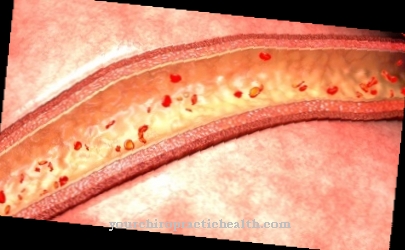In the Oral flora it is all of the microorganisms that colonize the human oral cavity. A functioning oral flora is an important prerequisite for dental health.
What is the oral flora?

The oral flora is understood to mean all microorganisms that settle in the human oral cavity. The name flora goes back to the earlier assumption that microorganisms such as bacteria belong to the plant kingdom. At the present time the oral flora is used within dentistry Microorganism society or Microorganism community called.
The colonization of the human oral flora takes place immediately after birth. Streptococci are one of the first types of bacteria to populate the mouth. Before that, the oral cavity of the growing fetus is still free of microorganisms. Only after the birth process do the germs have the opportunity to colonize the oral cavity.
Over time, the oral flora becomes more and more complex. If teeth are lost in old age, it is possible that the oral flora will regress again.
A distinction can be made between resident and transient oral flora, which depends on whether the oral cavity is colonized by the microorganisms permanently or only temporarily.
Function & task
The microorganisms that form the oral flora include hundreds of different types of bacteria and yeasts. These include, for example, streptococci such as Streptococcus salivarius, Streptococcus sanguis and Streptococcus mitis, lactobacilli, actinomycetes, Neisseria and Veillonella parvula.
Some types of bacteria in the oral flora, such as Streptococcus mutans, are also responsible for the development of tooth decay. They are known as cariogenic microorganisms.
In healthy people, fungi such as molds, yeasts or dermatophytes only settle on the surface of the skin and mucous membrane. Some Candida species also occur as harmless saprophytes in the human throat region. They were found in around 70 percent of all people examined. The colonization of the skin and mucous membranes by the Candida fungi are known collectively as candidiasis.
The oral flora is important for protecting the human oral cavity. The tissue there is protected from harmful influences by some types of bacteria, which support the immune system. The microorganisms are located like a biofilm on the tongue, mucous membranes and teeth. After eating the meals, the bacteria take over the first digestive processes. A healthy oral flora also contributes to a positive process for human digestion.
In total, there are around 600 types of bacteria and billions of bacteria in the human mouth. Scientists keep discovering new subtypes.
A healthy oral flora means that there is less tartar on the teeth. Some types of bacteria clean the teeth together with the saliva. This also helps counteract inflammation. Therefore, a healthy oral flora is extremely important for the teeth.
The bacteria find excellent conditions in the mouth for their survival and reproduction. These include warm temperatures, optimal humidity and nutrients from leftovers, which are good for microorganisms. Some types of bacteria have special properties. These are u. a. about attachment mechanisms, which allow the bacteria to adhere well to the teeth, oral mucosa and tongue.
You can find your medication here
➔ Toothache medicationIllnesses & ailments
If the oral flora is unbalanced, this can have harmful consequences for the oral cavity. Not all types of bacteria that make up the oral flora are benign. These are primarily the lactobacilli (lactic acid bacteria), the fusobacteria (pus bacilli) and the subspecies Streptococcus mutans. They have a positive effect on the development of tooth decay and feed mainly on food residues that contain sugar.
Since the bacteria are mainly on the teeth, their metabolic products can attack them and the neighboring gums. As a result, tooth decay and periodontal disease develop. Other types of bacteria that are found on the tongue, in turn, cause bad-smelling bad breath. These harmful microorganisms are present even in healthy oral flora.
For this reason, it is important to clean your teeth consistently and regularly so that the germs cannot cause any damage. It is particularly important to remove the plaque that is on the teeth. The plaque, which is a real focus of bacteria, can only be removed mechanically, like with a toothbrush. To effectively reduce the amount of plaque, it is also necessary to use small interdental brushes, dental floss and possibly mouthwashes.
There are various causes that can unbalance the oral flora. These include diet, nicotine consumption, alcohol consumption, inadequate oral hygiene and orthodontic treatments. But the use of antibiotics or some diseases such as diabetes mellitus (diabetes) and cancer are sometimes responsible for disorders of the oral flora. Due to the disturbed equilibrium, the harmful germs multiply undisturbed.
Bite injuries represent a further health problem in connection with the oral flora. There is a risk of infection from human or animal bites, as harmful microorganisms from the oral flora get into the wound. Deep injuries near a joint are particularly affected. The annual infection rate from bite wounds fluctuates between 15 and 20 percent. With a share of around 50 percent, the risk from human bites is highest.












.jpg)



.jpg)










.jpg)
